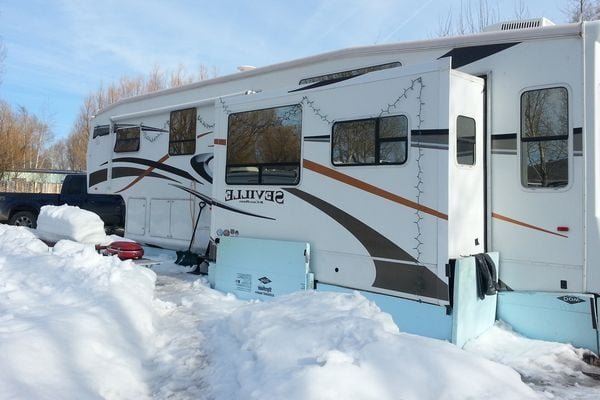Living in an RV in Winter
There are a number of factors to consider if you are planning on living in an RV during the winter. For example, the temperatures inside your RV can drop during the night, so you should bring a thermal sleeping bag to ensure a comfortable night’s sleep. Packing extra warm clothing also helps you to save on energy costs by not needing to turn up the heat as much as you would at home. You should also invest in a dehumidifier, which helps keep excess moisture from building up in your RV.
Insulate windows

If you’re living in an RV during the winter, one of the best ways to stay warm and cozy is to install window insulation. It’s easy to do. You can purchase RV window shrink wrap kits and apply them to your windows, which will keep out cold air and reduce heat loss. These window coverings are easy to apply with double-sided tape, and the film will trap a layer of air as an insulator.
If your windows aren’t insulated, they’ll lose heat when the temperature drops below freezing. The cold weather will make them feel icy, which is especially problematic if you’re living in an RV during the winter. Luckily, most RV windows are made of single-pane glass, and they can be insulated with bubble wrap or shrink wrap.
Install dehumidifiers
If you’re living in an RV, one of the best ways to combat high humidity is to install dehumidifiers. These devices can help you avoid mould and other symptoms of moisture buildup, and they can help you save energy while doing so. If you want to avoid the problems caused by humidity, here are some tips: first, determine the relative humidity level of your RV. If it’s more than 50 percent, you’ll need a higher-performing dehumidifier. Second, look for a dehumidifier with a convenient set-and-forget feature. This makes your life easier as it won’t require you to constantly monitor its operation.
Lastly, look for a dehumidifier that doesn’t produce excessive noise. A quiet unit won’t interfere with your RV space and won’t disrupt your music or TV. The Quiet RV Dehumidifier, for example, is very quiet and will remove ample amounts of moisture without causing any noise. Its automatic shut-off feature will stop working when the tank reaches its maximum capacity.
Install rugs
If you live in an RV, you can install rugs on the floor to help trap heat inside the camper during the winter. This way, you won’t have to worry about freezing the plumbing. Besides, they will make the floor warmer and more comfortable to walk on. A heated floor tape is also helpful in these situations.
You can also install foam insulation boards for extra protection during winter RV trips. These boards will not only give you additional insulation, but they will also create a barrier to keep out damp. The more insulation you have in your RV, the more comfortable you’ll feel. If you’re traveling in an RV that’s large in size, consider installing thick rugs on the floor to keep the floor warmer. In addition to this, you can use carpet sheets to cover more area and give you a more cozy feel when you step onto the RV floor.
Insulate floors
In the winter, it’s important to protect the floor of your RV with insulation. This can be done in a variety of ways. First, remove any old flooring. You can also remove appliances and furniture. Then, clean the subfloor. Next, measure and cut the first piece of insulation. You should then test fit it and spray it with adhesive.
To insulate windows and other openings in an RV, you can use window film, reflective foil, or insulating fabric. You can also use foamboard or bubble wrap to create a custom blackout covering. Foamboard or heavy rugs can also be used to insulate floors.
Prepare HVAC system
If you are planning to stay in an RV for the winter, you will need to prepare the HVAC system. Install insulated windows and doors to reduce condensation and keep your RV warm. If you have sliders, make sure to install extra layers of insulation on the sidewalls. You can also install a heater for the water in your RV’s intake hose.
You will also need to check the RV’s AC unit. This system is similar to a refrigerator and works by sucking warm air out of the RV’s cabin and drawing cooler air in. You can check the voltage and amp capacity of the system on the control panel.
